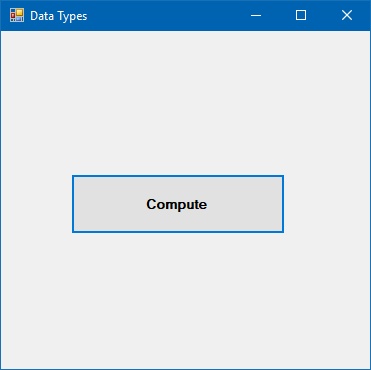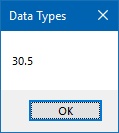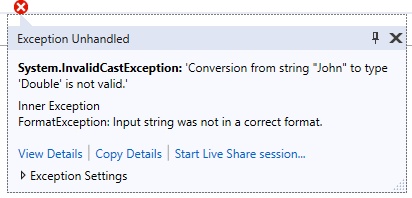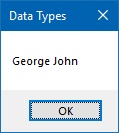In our daily life, we have to deal with all kinds of information and data. For example, we need to deal with data like names, money, phone number, addresses, date, stock quotes and more.
Similarly, in Visual Basic 2019, we have to deal with all sorts of data, some of them can be mathematically calculated while some are in the form of text or other non-numeric forms. In Visual Basic 2019, data can be stored as variables, constants or arrays. The values of data stored as variables always change, just like the contents of a mailbox or the storage bin while the value of a constant remains the same throughout.
Visual Basic 2019 classifies information into two major data types, the numeric data types, and the non-numeric data type
In Visual Basic 2019, numeric data types are types of data comprises numbers that can be calculated using various standard arithmetic operators. Examples of numeric data types are examination marks, height, body weight, the number of students in a class, share values, the price of goods, monthly bills, fees, bus fares and more. In Visual Basic 2017, numeric data are classified into seven types based on the range of values they can store. Numeric data that involve round figures are classified as Integer or Long integer. Data that require high precision calculation are classified as single and double precision data types, they are also called floating point numbers. Numeric data that involve money are classified as currency data types. Lastly, data that require more precision and involve many decimal points are classified as decimal data types. These data types are summarized in Table 8.1
| Type | Storage | Range of Values |
|---|---|---|
| Byte | 1 byte | 0 to 255 |
| Integer | 2 bytes | -32,768 to 32,767 |
| Long | 4 bytes | -2,147,483,648 to 2,147,483,648 |
| Single | 4 bytes | -3.402823E+38 to -1.401298E-45 for negative values 1.401298E-45 to 3.402823E+38 for positive values. |
| Double | 8 bytes | -1.79769313486232e+308 to -4.94065645841247E-324 for negative values 4.94065645841247E-324 to 1.79769313486232e+308 for positive values. |
| Currency | 8 bytes | -922,337,203,685,477.5808 to 922,337,203,685,477.5807 |
| Decimal | 12 bytes | +/- 79,228,162,514,264,337,593,543,950,335 if no decimal is use +/- 7.9228162514264337593543950335 (28 decimal places). |
In Visual Basic 2019, non-numeric data types are data that cannot be calculated using standard arithmetic operators. The non-numeric data comprises text or string data types, the Date data types, the Boolean data types that store only two values (true or false), Object data type and Variant data type. They are summarized in Table 8.2
| Type | Storage | Range |
|---|---|---|
| String(fixed length) | Length of string | 1 to 65,400 characters |
| String(variable length) | Length + 10 bytes | 0 to 2 billion characters |
| Date | 8 bytes | January 1, 100 to December 31, 9999 |
| Boolean | 2 bytes | True or False |
| Object | 4 bytes | Any embedded object |
| Variant(numeric) | 16 bytes | Any value as large as Double |
| Variant(text) | Length+22 bytes | Same as variable-length string |
Literals are values that you assign to data. In some cases, we need to add a suffix behind a literal so that Visual Basic 2019 can handle the calculations more accurately. For example, we can use num=1.3089! for a single precision data type, num=1.3089# for a double precision data type, num=130890& to indicate long integer data type and num=1.3089@ to indicate currency data type. The suffixes are summarized in Table 8.3.
| Suffix | Data Type |
|---|---|
| & | Long |
| ! | Single |
| # | Double |
| @ | Currency |
In addition, we need to enclose string literals within two quotations and date and time literals within two # sign. Strings can contain any characters, including numbers. The following are few examples:
memberName="Turban, John." TelNumber="1800-900-888-777" LastDay=#31-Dec-00# ExpTime=#12:00 am#
When VB2019 performs operation using arithmeric operators, it need to understand the data types. It can perform mathematical operations on data of numeric nature but not a mix of numeric data and non-numeric data.
For example, we can add two numbers but not a number and a text or phrase. Let's examine the following examples. Start a project and add a button to the default form, name the button as BtnCompute and change its text to Compute, as shown in Figure 8.1.

In this example, click on the Compute button and enter the following code:
Private Sub BtnCompute_Click(sender As Object, e As EventArgs) Handles BtnCompute.Click
MsgBox(10 + 20.5)
End Sub
Running the program and click on the Compute button produces the following output:

In this example, click on the Compute button and enter the following code:
Private Sub BtnCompute_Click(sender As Object, e As EventArgs) Handles BtnCompute.Click
MsgBox(10 + "John")
End Sub
Running the program and click on the Compute button produces the error message as shown in Figure 8.3, because numeric data and string cannot add:

In this example, click on the Compute button and enter the following code:
Private Sub BtnCompute_Click(sender As Object, e As EventArgs) Handles BtnCompute.Click
MsgBox("George" + " John")
End Sub
Running the program and click on the Compute button produces output as shown in Figure 8.4, because the plus operator does not add the strings, but concatenates them.

Note: You can also concatenate two strings using the ampersand sign &, as follows:
MsgBox("George" & " John")
Copyright©2008 Dr.Liew Voon Kiong. All rights reserved |Contact|Privacy Policy
Last update:03/29/2024 08:33:08